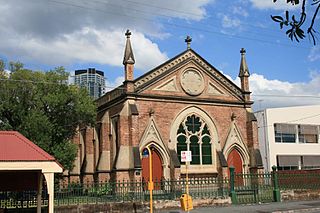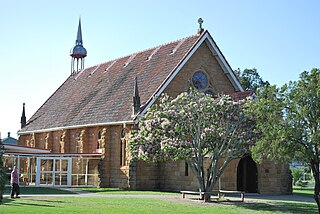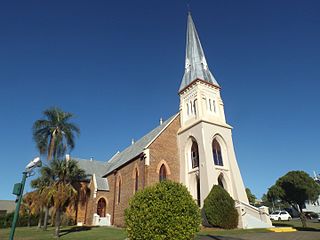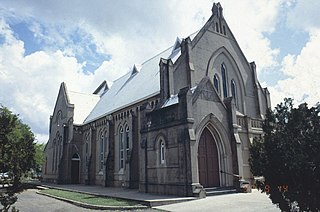
Esk is a town and locality in the Somerset Region in South East Queensland, Australia. In the 2016 census, Esk had a population of 1,698 people.

St Andrews Uniting Church is a heritage-listed church at 131 Creek Street, Brisbane CBD, City of Brisbane, Queensland, Australia. It was designed by George David Payne and built in 1905 by Alexander Lind & Son. Initially St Andrews Presbyterian Church, it became part of the Uniting Church following the merger of the Presbyterian, Methodist and Congregational Churches in 1977. It was added to the Queensland Heritage Register on 21 October 1992.

St Andrew's Church is a heritage-listed Anglican church at 2 Mangerton Street, Toogoolawah, Somerset Region, Queensland, Australia. It was designed by Robin Dods and built from 1911 to 1912 by local builder Donald Alexander Menzies at a cost of £839. It was added to the Queensland Heritage Register on 21 October 1992.

St Andrews Anglican Church is a heritage-listed churchyard at 160 Vulture Street, South Brisbane, City of Brisbane, Queensland, Australia. It was designed by Andrea Stombuco and built from 1878 to 1932. It was added to the Queensland Heritage Register on 21 October 1992.

St Agnes Anglican Church is a heritage-listed churchyard at Ipswich Street, Esk, Somerset Region, Queensland, Australia. It was designed by John Hingeston Buckeridge and built in 1889 by Lars Andersen. It is also known as St Agnes Rectory and Church Hall. It was added to the Queensland Heritage Register on 21 October 1992.

Wesley Uniting Church is a heritage-listed former church at 54 Neil Street, Toowoomba, Toowoomba Region, Queensland, Australia. It was designed by Willoughby Powell and built from 1877 to 1924. It is also known as Wesleyan Methodist Church. It was added to the Queensland Heritage Register on 10 May 1997.

St John the Baptist Anglican Church is a heritage-listed church at 171 Oxford Street, Bulimba, Brisbane, Queensland, Australia. It was designed by John Hingeston Buckeridge and built in 1888 by T Whitty. It was added to the Queensland Heritage Register on 9 July 2003.

Ann Street Presbyterian Church is a heritage-listed church at 141 Ann Street, Brisbane City, City of Brisbane, Queensland, Australia. It was built in 1858 by Joshua Jeays, altered and extended in 1897 to a design by Alexander Brown Wilson with further extensions designed by Douglas Francis Woodcraft Roberts in 1936. The church was added to the Queensland Heritage Register on 21 October 1992.

St Paul's Presbyterian Church is a heritage-listed church at 43 St Pauls Terrace, Spring Hill, City of Brisbane, Queensland, Australia. It was designed by Francis Drummond Greville Stanley and built from 1887 to 1889 by Thomas Rees. It was added to the Queensland Heritage Register on 21 October 1992.

St Paul's Presbyterian Church Hall is a heritage-listed church hall at 43 St Pauls Terrace, Spring Hill, City of Brisbane, Queensland, Australia. It was designed by Francis Drummond Greville Stanley and built in 1886. It is also known as Sabbath School Hall. It was added to the Queensland Heritage Register on 21 October 1992.

Old St Stephens Church is a heritage-listed Roman Catholic church at 249 Elizabeth Street, Brisbane City, City of Brisbane, Queensland, Australia. It was designed by A W Pugin and built from 1849 to 1850 by Alexander Goold and Andrew Petrie. It is also known as Pugin Chapel. It was added to the Queensland Heritage Register on 21 October 1992.

St Davids Anglican Church is a heritage-listed church at 1 Church Street, Allora, Southern Downs Region, Queensland, Australia. It was designed by Francis Drummond Greville Stanley and built from 1887 to 1901. It is also known as St David's Church of England. It was added to the Queensland Heritage Register on 24 March 2000.

St Augustines Anglican Church is a heritage-listed church at Dove Street, Leyburn, Southern Downs Region, Queensland, Australia. It was designed by Richard George Suter and built from 1871 to 1918. It is also known as St Augustine's Church of England. It was added to the Queensland Heritage Register on 21 August 1992.

Warwick Uniting Church is a heritage-listed church at 37 Guy Street, Warwick, Southern Downs Region, Queensland, Australia. It was built from 1869 to 1922. It is also known as St Andrews Presbyterian Church. It was added to the Queensland Heritage Register on 24 March 2000.

St Stephen's Church & Hall is a heritage-listed Presbyterian churchyard at 22 Limestone Street, Ipswich, City of Ipswich, Queensland, Australia. It was designed by Joseph Backhouse and built from 1865 to 1978. It was added to the Queensland Heritage Register on 21 October 1992.

Cressbrook Homestead is a heritage-listed homestead at off Cressbrook-Caboombah Road, Cressbrook, Somerset Region, Queensland, Australia. It was built from 1841 to 1914. It was added to the Queensland Heritage Register on 21 October 1992.

St Andrew's Church Hall is a heritage-listed church hall at Mangerton Street, Toogoolawah, Somerset Region, Queensland, Australia. It was built in 1906 by A D Menzies. It was added to the Queensland Heritage Register on 21 October 1992.

St Andrew's Rectory is a heritage-listed detached house at Mangerton Street, Toogoolawah, Somerset Region, Queensland, Australia. It was built in 1925. It was added to the Queensland Heritage Register on 21 October 1992.

St Andrew's Presbyterian Church is a heritage-listed church at 280 Bolsover Street, Rockhampton, Rockhampton Region, Queensland, Australia. It was designed by Voller & Graham built from 1893 to 1926. It was added to the Queensland Heritage Register on 21 October 1992.

Shepherd Memorial Church of St Peter is a heritage-listed Anglican church at the corner of Drake Street and Wondai Road, Proston, South Burnett Region, Queensland, Australia. It was designed by Fowell, McConnel and Mansfield and built from 1937 to 1939 by Lesleigh George Windmell Smith. It was added to the Queensland Heritage Register on 9 November 2012.





















